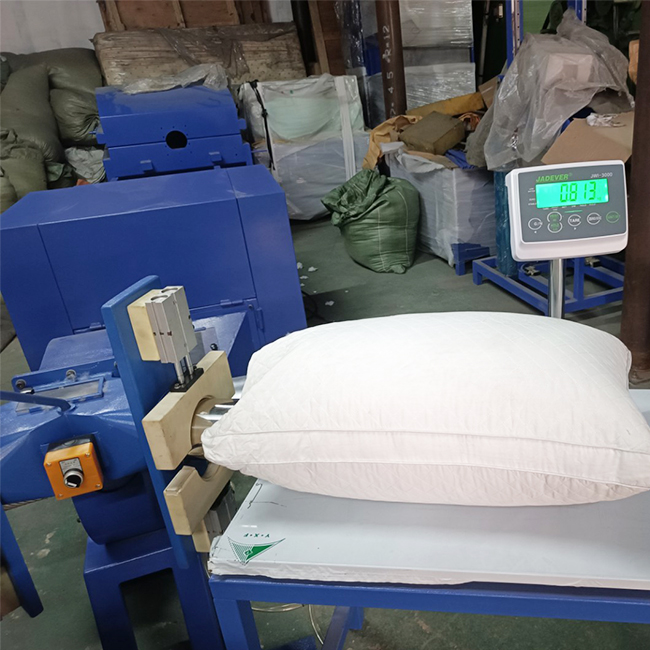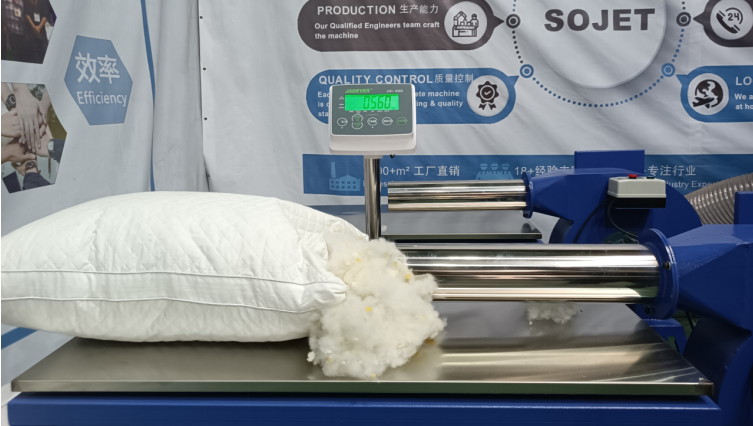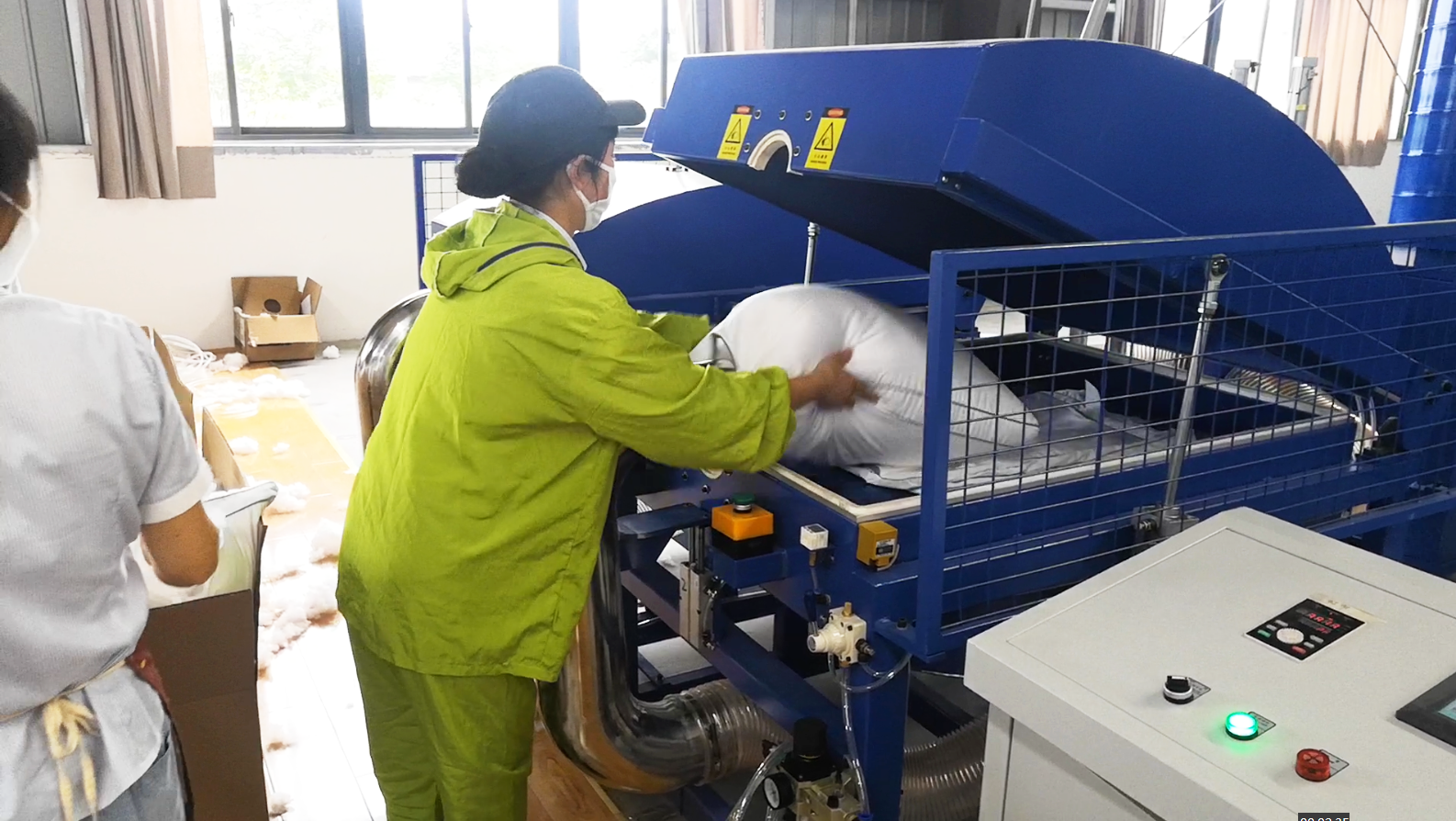
Views: 0 Author: Site Editor Publish Time: 2024-09-11 Origin: Site
Pillows are a universal staple in households worldwide, offering comfort and support. However, few people consider the complex processes involved in manufacturing these everyday items. A key component in the mass production of pillows is the pillow stuffing machine. This article explores what a pillow stuffing machine is, how it works, and its benefits in the pillow-making process.
A pillow stuffing machine is an industrial device designed to fill pillows with stuffing materials like polyester fiber, feathers, or foam in a consistent and automated manner. It eliminates manual labor in stuffing pillows, significantly speeding up the production process and ensuring uniform quality across all products. In this article, we'll delve into how these machines function, the different types available, and their role in an automatic pillow production line.

The working mechanism of a pillow stuffing machine is quite efficient, designed to fill large quantities of pillows at a rapid pace while maintaining consistency. The machine typically consists of a hopper or storage tank where the filling material is loaded. From here, the stuffing is funneled through a conveyor system and then injected into the pillowcase using a nozzle.
The filling process is highly controlled to ensure that each pillow receives the right amount of stuffing, a task that's difficult to achieve manually. Modern pillow stuffing machines come with adjustable settings that allow operators to control the density of the filling based on the type of pillow being produced.
Some machines even have multiple stuffing options, allowing manufacturers to mix materials, such as combining down feathers with polyester for premium pillows. The automation in these machines minimizes waste, reduces errors, and ensures every pillow is filled to the desired specifications.
There are several different types of pillow stuffing machines, and they vary based on their level of automation and purpose. Below are the main categories:
Manual Pillow Stuffing Machine: These machines require human intervention for most of the stuffing process. Although rarely used in mass production, they are sometimes found in small-scale operations or artisan pillow-making businesses. Manual machines are labor-intensive and are typically slower than automated models.
Semi-Automatic Pillow Stuffing Machine: This type of machine combines some manual operations with automatic stuffing. The operator manually loads the pillowcases onto the machine, while the stuffing process is handled automatically. Semi-automatic machines offer a middle ground for small to medium-sized businesses that need more speed and efficiency than a manual machine can provide.
Fully Automatic Pillow Stuffing Machine: As the name suggests, these machines are entirely automated, requiring little to no human intervention. From loading the pillowcases to controlling the stuffing volume, a fully automatic pillow stuffing machine can handle large-scale production with minimal labor. It’s often integrated into an automatic pillow production line for continuous, high-speed operation.

In large-scale manufacturing, pillow stuffing machines are often part of a larger automatic pillow production line, which integrates various machines for cutting, sewing, stuffing, and packaging pillows. This seamless workflow not only boosts productivity but also ensures that each stage of pillow production is standardized, from fabric cutting to final packaging.
For example, an automatic pillow production line may begin with fabric being cut and sewn into pillowcases. These cases are then automatically transferred to the pillow stuffing machine, where they are filled with the desired amount of material. After stuffing, the pillows are sealed and sent for final packaging, all without human intervention. This level of automation helps manufacturers meet the growing demand for pillows while ensuring consistency and reducing production costs.
There are several advantages to incorporating a pillow stuffing machine into your production process, particularly if you're involved in large-scale pillow manufacturing. Some key benefits include:
Increased Efficiency: One of the most significant advantages of a pillow stuffing machine is its ability to produce large quantities of pillows in a short time. Manual stuffing can be labor-intensive and time-consuming, while automated machines can fill hundreds of pillows per hour.
Consistency: These machines ensure that each pillow is filled with the same amount of material, which is vital for maintaining product quality and uniformity. This consistency is difficult to achieve with manual labor.
Cost Savings: Although the initial investment in a pillow stuffing machine might be substantial, the long-term savings on labor costs make it worthwhile. Machines also reduce material waste by accurately controlling the amount of stuffing used in each pillow.
Flexibility: Many machines can accommodate various types of filling materials, from polyester fiber to memory foam. Some models even allow manufacturers to produce custom pillows by adjusting the stuffing density.
Quality Control: With precise control over stuffing amounts and types, the machine ensures that each pillow meets the required specifications. This helps maintain a high standard of quality in mass production.

A typical pillow production line consists of multiple machines working together to automate the entire manufacturing process. The key components include:
Fabric Cutting Machine: This machine cuts the fabric into the appropriate sizes for pillowcases. It often works in tandem with other machines in the production line.
Sewing Machine: Once the fabric is cut, the sewing machine stitches the pillowcases, leaving an opening for the stuffing.
Pillow Stuffing Machine: As discussed, this machine fills the pillowcases with the selected stuffing material.
Sealing and Packaging Machine: After the pillows are stuffed, they move to a machine that seals the open ends and prepares them for packaging.
Each of these machines plays an essential role in producing pillows at scale, and the integration of these machines into an automatic pillow production line ensures a smooth, efficient manufacturing process.
A pillow stuffing machine can handle a variety of materials, including polyester fiber, foam, down, and feathers.
Depending on the model, a pillow stuffing machine can fill hundreds of pillows per hour, making it ideal for large-scale production.
Yes, most modern machines come with adjustable settings to accommodate various pillow sizes and stuffing densities.
In conclusion, the pillow stuffing machine is a vital component in the manufacturing of pillows, enabling companies to produce high-quality, consistent products efficiently. Whether part of an automatic pillow production line or used as a standalone unit, these machines are indispensable for modern pillow manufacturing, ensuring both speed and precision.
